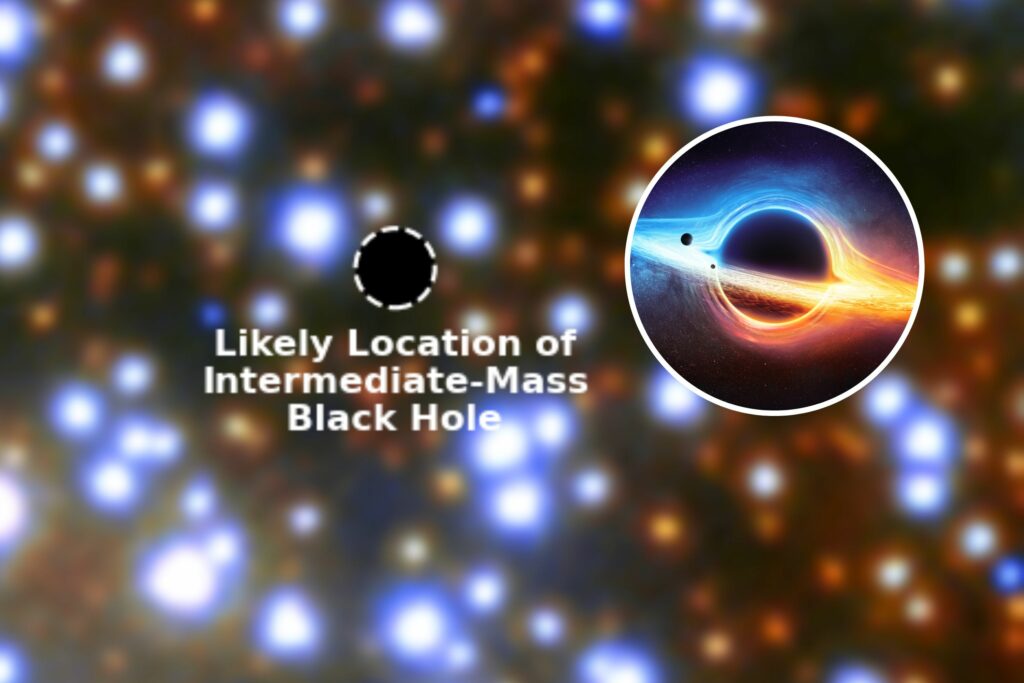A rare “massive” black hole has been discovered about 18,000 light years from our planet—the closest of its type to our solar system ever found—after fast-moving stars provided “smoking gun” evidence of its existence.
The intermediate-sized black hole—thought to have a mass of 20,000 times that of our own sun—was discovered lurking in the center of a cluster of 10 million stars named Omega Centauri, according to a new paper in the journal Nature.
This marks a rare uncovering of an intermediate-sized black hole, which may be a result of a smaller galaxy being swallowed by our Milky Way.
Colored ESA/Hubble image of Omega Centauri with the likely position of the intermediate-mass black hole (main) and a stock image of a black hole (inset). This is a rare discovery of an intermediate-sized black hole….
ESA/Hubble & NASA, M. Häberle MPIA / ISTOCK / GETTY IMAGES PLUS
The discovery was made after astronomers used 20 years’ worth of images taken by the Hubble Space Telescope to study over a million stars in the Omega Centauri cluster, and compared them to theoretical models of how the stars would move if a black hole were indeed present. A black hole was long suspected to be present in the center of the cluster, but has only now been confirmed to exist.
“Led by the Max-Planck-Institut für Astronomie in Germany, our team searched for fast-moving stars expected to exist near concentrated masses, like black holes,” study co-author Holger Baumgardt, an associate professor of astrophysics at the University of Queensland, Australia, said in a statement.
“Identifying these stars was the smoking gun evidence we needed to prove the black hole’s existence, and we did,” he said. “When I saw the data, I immediately knew we found something special. Astronomers have tried to find one of these black holes for over 20 years, and now we have finally succeeded.”
The astronomers found that the observed movements of seven fast-moving stars could only be explained by the presence of a black hole around 20,000 times the mass of our own sun. This would make the black hole a sort of “missing link” between the smaller stellar black holes and much larger supermassive black holes.
Stellar black holes are formed from the remnants of massive stars that have undergone supernova explosions, and usually have masses ranging from about five to 150 times the mass of our sun. Supermassive black holes are much larger, with masses ranging from hundreds of thousands to billions of times the mass of the sun. They are found at the centers of most galaxies, including our Milky Way.
A 3 panel zoom into a new colored ESA/Hubble image of Omega Centauri and the black hole. This marks the closest massive black hole to Earth.
ESA/Hubble & NASA, M. Häberle MPIA
This black hole, with a mass of 20,000 solar masses, is therefore somewhere in between. It also marks the closest “massive” black hole—larger than stellar black holes—found to our planet at 18,000 light years away, beating our galaxy’s central supermassive black hole Sagittarius A*, which is about 27,000 light years away.
“This class of black holes has been a theory for decades but is now fully confirmed to exist,” Baumgardt said.
This may be because Omega Centauri was originally the core of a young galaxy, with the black hole being a teenage galactic core that would have eventually grown to a supermassive black hole. However, the black hole’s growth may have been stunted after the Milky Way swallowed up the smaller galaxy, leaving it “frozen in time.”
“Previous studies had prompted critical questions of, ‘So, where are the high-speed stars?’ We now have an answer to that and the confirmation that Omega Centauri contains an intermediate-mass black hole. At a distance of about 18,000 light-years, this is the closest known example of a massive black hole,” co-author Nadine Neumayer, a group leader at the Max Planck Institute for Astronomy, said in another statement.
The astronomers hope to further investigate this rare black hole, and find out more about its evolution and the stars orbiting it.
“I think this will invigorate the field and lead to a lot of new research in this area,” Baumgardt said. “We can begin to speculate how this black hole formed, how it’s related to other massive black holes astronomers have found and where other intermediate-mass black holes might exist.
“It’s a thrilling time to be an astronomer and we’re excited to see where our discovery will lead.”
Do you have a tip on a science story that Newsweek should be covering? Do you have a question about massive black holes? Let us know via science@newsweek.com.
Uncommon Knowledge
Newsweek is committed to challenging conventional wisdom and finding connections in the search for common ground.
Newsweek is committed to challenging conventional wisdom and finding connections in the search for common ground.
>>> Read full article>>>
Copyright for syndicated content belongs to the linked Source : Newsweek – https://www.newsweek.com/black-hole-discovered-star-cluster-galaxy-massive-1923347
